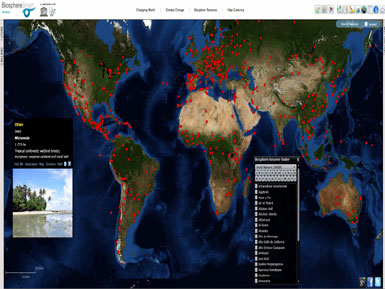These days, governments can no longer be relied on to protect places like the Amazon and nonprofits and foundations have taken up the cause.
After spending $358 million to protect the Amazon, The Gordon and Betty Moore Foundation have pledged another $100 million, to be spent in the next five years.
"Over 15 years, our grantees have helped conserve more than 140 million hectares in the Amazon," says Avecita Chicchón, who heads the foundation’s Andes Amazon Initiative. 400 million hectares are now protected in the the Amazon Basin.
Started by Intel’s co-founder, the foundation is the biggest private supporter of Amazon conservation.
The money will be spent to: create and consolidate existing reserves and indigenous territories; secure management and monitoring of national parks; and support policies that integrate forest protection into land-use planning.
"Working at these different scales, from individual conservation units to land-use mosaics to national park systems, we believe we can help create a regional conservation infrastructure," says Guillermo Castilleja, the foundation’s chief program officer for Environmental Conservation. "This approach will help ensure the long-term resilience and durability of the exemplary gains in forest conservation that our Andes Amazon Initiative grantees and others have worked so hard to accomplish."
Deforestation is currently surging in Peru and other Amazonian countries, and is always tempting as a way to boost local economies. There’s always political pressure to weaken environmental laws.
Moore also works to stabilize the Amazon’s beef and soy industries to make sure they don’t keep pushing into the rainforest. "We want to help make sure that local communities and the management and finance structures for conservation units have the resilience and long-term resources they need so conservation gains can withstand current and foreseeable pressures," Chicchón told Mongabay.
Last year, conservation groups established Peru’s 3.3 million-acre Sierra del Divisor national park, the final link in a 67 million-acre Andes-Amazon Conservation Corridor – one of the largest contiguous protected areas in the Amazon.
Read our articles, Pledges at COP21 Would Restore 482,000 Square Miles of Degraded Lands and Half From Renewables, Half From Forest Protection, That’s How To Address Climate Change.
World Gets 20 New Biosphere Reserves
In March, UNESCO designated 20 new World Biosphere Reserves, and increased the size of nine reserves.
There are now 669 Biosphere Reserves in 120 countries, considered the most important hot spots for nature left on earth. Designation doesn’t come with protection, but often leads to that.

Two new Reserves are in Canada. Tsá Túé International Biosphere Reserve in the far north, protects one of the largest, most pristine lakes in the world, Great Bear Lake. Caribou, wolves, grizzly bears, muskox, and many other species live there. At 9.3 million hectares, it is the largest UNESCO biosphere reserve in North America.
Beaver Hills, in Alberta, Canada, protects parts of the Boreal Forest so far spared from tar sands development.
Other new Reserves are in Algeria, Tanzania, Ghana, Haiti, India, Indonesia, Philippines, Iran, Italy, Portugal, the UK, Kazakhstan, Madagascar, Mexico, Morocco, and Peru.
Read short descriptions here:
